SPAIN
Bilbao

Bilbao
Bilbao
Bilbao is the largest city in the Spanish Basque Country. It is also the capital of Biscay a province in Spain. Bilbao was founded on June 15, 1300 by Diego López V of Haro, Lord of Biscay. The town's name is derived from the Basque "bi albo" or "two banks". Bilbao sided with the Republican government in the Spanish Civil War and was also the capital of the first Basque autonomous government. Bilbao has its own Guggenheim Museum built by the architect Frank Gehry. It is a major tourist attraction.
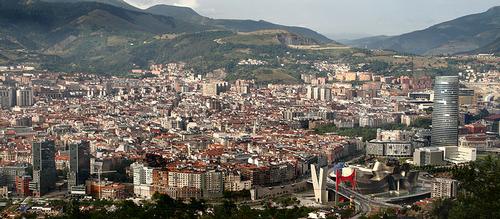 BilbaoPhoto: Andrea Bocchino CC 3.0 Unported no changes made
BilbaoPhoto: Andrea Bocchino CC 3.0 Unported no changes made
| advertisement |
| Hotels Bilbao |
Location
Bilbao is located in the north of Spain on the Bay of Biscay and lies on the river Nervion. Bilbao is located on one of the pilgrimage routes to Santiago de Compostella. The city covers an area of 41.3 square kilometers and has a population of 354,000 in the city center. Greater Bilbao has about a million inhabitants and is the economic and industrial center of Northern Spain.
Weather
The proximity and influence of the Cantabrian sea ensure that Bilbao has a maritime climate with precipitation all year round, including in summer. The precipitation is heavy, in total 45% of the days are rainy and 40% cloudy. The most rain falls between October and April, November is the wettest month. The mean maximum temperature varies between 25 °C (77.0 °F) and 26 °C (78.8 °F) in the summer months, while the mean minimum temperature in winter is between 6 °C (42.8 °F) and 7 °C (44.6 °F). The best time to visit Bilbao is between April and October.
History
Remains of an ancient settlement have been found on top of Malmasín Mountain and date back to around the 3rd or 2nd century BC. The lord of Biscay, Diego López V of Haro, founded Bilbao and obtained city rights in Valladolid on June 15, 1300. These city rights were confirmed by King Ferdinand IV of Castile in Burgos on January 4, 1301. The new city was built on the right bank of the river Nervión.
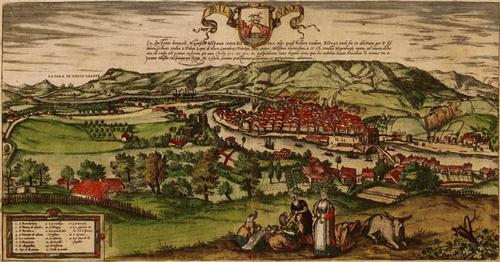 Bilbao in 1575Photo: Public domain
Bilbao in 1575Photo: Public domain
In 1602 Bilbao became the capital of Biscay, the title previously held by Bermeo. In the following centuries the city's wealth increased, especially after the discovery of iron in the surrounding mountains. At the end of the 17th century, Bilbao overcame the economic crises that hit Spain thanks to its iron ore and trade with England and the Netherlands. During the 18th century, the city continued to grow and Bilbao faced a lack of space. The Basque Country was one of the most important battlegrounds during the Carlist Wars.
The Spanish Civil War started in Bilbao with minor uprisings that were quelled by the republican forces. In May 1937, the Nationalist army laid siege to the city. The battle lasted until June 19 of that year, when Lieutenant Colonel Putz destroyed all bridges in Bilbao and the troops of 5th Brigade took Bilbao.
After the fall of Franco in Spain and the transition to a constitutional monarchy, in a process known in Spain as the transition, democratic elections could once again be held in Bilbao. In Bilboa there was a lot of support for the Basque nationalists. Since the 1990s, Bilbao has focused more on tourism and recreation than on heavy industry.
Sghts
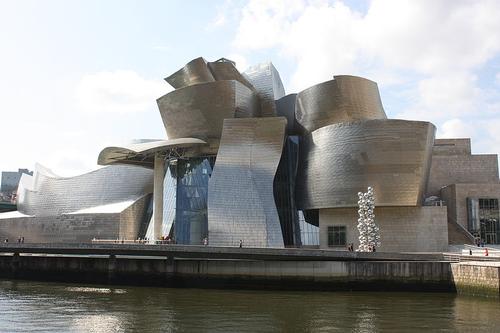 Bilbao GuggenheimPhoto: Ardfern CC 3.0 Unported no changes made
Bilbao GuggenheimPhoto: Ardfern CC 3.0 Unported no changes made
Bilbao is a beautiful city with several attractive sights that attract visitors. Bilbao has several museums such as the Guggenheim Museum. It is mainly the titanium shell that makes Frank Gehry's Guggenheim Museum Bilbao special. The illuminated material is like a magnet to the eye and gives the building a unique place in architectural history. The graceful, sensual curves give the impression of ships that used to lie all along Bilbao's docks. In keeping with the maritime theme, the skylights of the main gallery (known as the Fish gallery) are designed to resemble the fins of a fish. Many parts of the building are purely decorative. The permanent collection is not very special, but the museum always has guest curators who often create fascinating temporary exhibitions. Often one also sees masterpieces from the other Guggenheim collections.
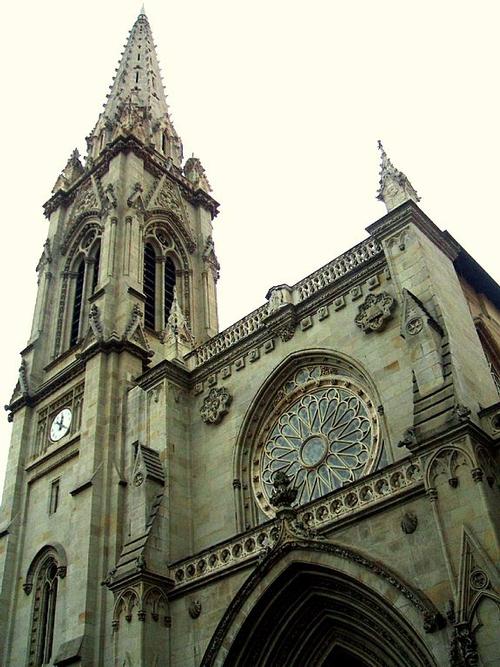 Bilbao CathedralPhoto: Zarateman in the public domain
Bilbao CathedralPhoto: Zarateman in the public domain
In the old center of Bilbao you will find the Cathedral of Santiago. The cathedral dates back to the 14th century and is located on one of the pilgrimage routes towards Santiago de Compostella. The cathedral was destroyed in the 16th century and rebuilt in a mix of styles. The styles are mainly Renaissance and Gothic. In the 19th century, a neo-Gothic facade and tower were added.
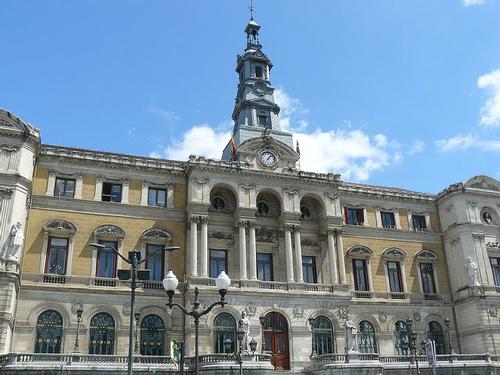 Bilbao Town HallPhoto: Fernando Pascullo CC 3.0 Unported no changes made
Bilbao Town HallPhoto: Fernando Pascullo CC 3.0 Unported no changes made
Bilbao also has a Museum of Fine Arts and the Maritime Museum as well as other churches such as the Church of St. Anton, the Basilica of Begoña and the Church of St. Nicholas of Bari. Other places of interest are the Arriaga theater, the town hall, the Chavarri palace, the Plaza Nueva, the Ribera market, the San Mames stadium, the University of Deusto and the Zubizuri Bridge. The Calatrava bridge, the newly built bridge in the city is definitely worth a visit.
Tips
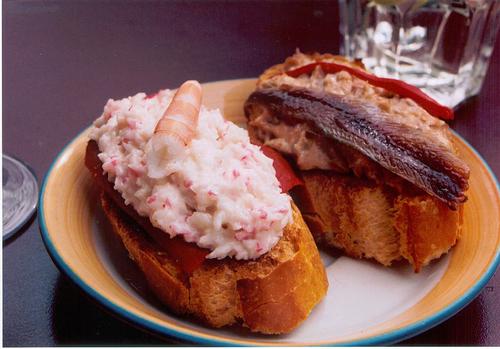 Pixtos BilbaoPhoto: Ardo Beltz CC 3.0 Unported no changes made
Pixtos BilbaoPhoto: Ardo Beltz CC 3.0 Unported no changes made
In Bilbao you can get acquainted with Basque cuisine very well. Bilbao has a very good international reputation. There are many Basque chefs with Michelin stars. It will therefore not be a problem to eat out in Bilbao. You can also eat out very cheaply. The Basque version of the tapas are the pintxos, which are slightly more refined than the tapas. In addition to the businesses that serve pintxos, you will find countless cozy simple eateries and restaurants.
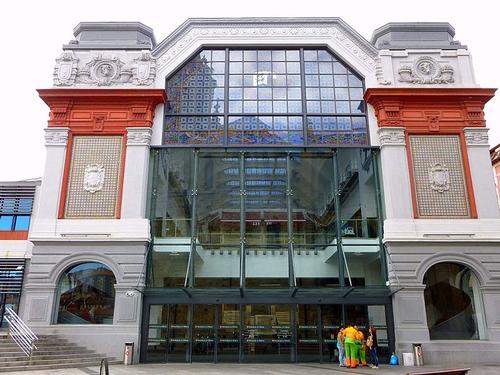 Mercado de la Ribeira BilbaoPhoto: Zarateman CC 4.0 International no changes made
Mercado de la Ribeira BilbaoPhoto: Zarateman CC 4.0 International no changes made
Most bars can be found in the center of Bilbao and in Abando. Two of the most famous discos are Congreso, at Muelle de Uribitarte and Distrito 9 in Alameda de Recalde. National and international DJs are often behind the turntable here. You can shop in the old center with the largest covered market in Europe, the Mercado de la Ribera. Furthermore, the area around the Guggenheim Museum is becoming increasingly important as a shopping area. The most sought-after souvenir is the Basque beret.
Useful links Bilbao
BBC Country ProfilesWorld Fact Book Explore all Countries
How to call
Last updated June 2025
Copyright: Team - The World of Info